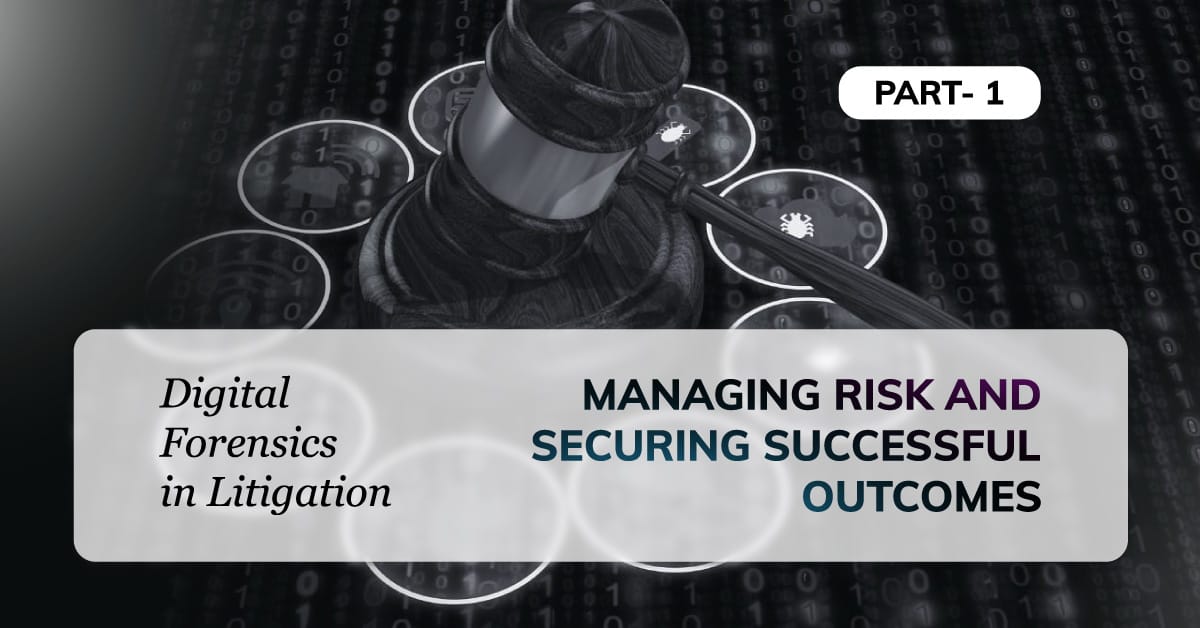Kris Carlson, Chief Operating Officer, former Digital Forensics Investigator
In an era where digital data is at the heart of business operations, digital forensics has become indispensable for managing litigation risk and improving the likelihood of a favorable outcome. From emails and text messages to cloud backups and social media posts, digital evidence can shape the trajectory of a legal dispute. Leveraging forensic techniques to collect, analyze, and preserve electronic data can significantly strengthen an organization’s position in court, reduce the risk of evidentiary gaps, and ensure compliance with legal obligations.
In Part 1 of this article, we explore why digital forensics matters and how it supports eDiscovery and Litigation. Part 2 will cover common use cases, pitfalls, and best practices.
Why Digital Forensics Matters
- Enhanced Evidence Reliability
A key advantage of digital forensics is data authenticity. Forensically sound processes—such as creating and verifying exact bit-by-bit copies (often referred to as “forensic images” or “preservation”) of electronic devices—maintain the integrity of potential evidence. This approach aligns with the Federal Rules of Civil Procedure (FRCP), which emphasizes the need to preserve accurate and complete records during eDiscovery. (11) When collection and handling practices follow recognized legal and technical standards, the credibility of electronic evidence grows substantially.
For instance, if an employee is alleged to have stolen trade secrets or confidential client information, standard IT backups or simple copies of files may fail to capture metadata critical to the investigation. Forensic imaging and specialized tools can reveal hidden footprints—like file creation dates, modification histories, or user access logs—that confirm the authenticity of the data and connect it to a particular user or time frame. Such nuances can be critical in either proving or disproving allegations.
- Risk Management and Compliance
Failing to collect or preserve digital evidence properly can lead to spoliation (the alteration or destruction of evidence), which can result in civil sanctions, adverse inference rulings, or other costly legal consequences. (22) By involving digital forensics professionals early on, legal teams can minimize the risk of mishandled data and stay in compliance with the evolving standards of eDiscovery. According to the Sedona Conference, well-executed digital forensic methods can also help organizations avoid expensive penalties by proving or disproving allegations of destroyed or missing data. (33)
Moreover, industries with strict regulatory frameworks—such as finance, healthcare, and government—benefit from comprehensive digital forensic strategies. These sectors often face heightened scrutiny around data breaches or improper handling of confidential information. By preparing a defensible plan for collecting and analyzing digital evidence, organizations can avoid regulatory penalties and protect their reputations. This approach not only safeguards legal interests but also proves essential in crisis management, where a swift and accurate understanding of what happened can mitigate further damage.
- Uncovering Hidden Information
Crucial data is often hidden or obscured, from deleted files that remain in unallocated space on a hard drive to encrypted or password-protected mobile devices. Digital forensic experts use specialized tools and methodologies—based on industry guidelines like NIST SP 800-86 (Guide to Integrating Forensic Techniques into Incident Response)—to dig deeper and even recover information thought to be lost (44). Access to this “invisible” data can yield pivotal insights that would otherwise remain undiscovered.
For example, in intellectual property disputes, timestamps and metadata can reveal how, when, and by whom certain files were accessed or altered—key evidence if a competitor or rogue employee is suspected of misappropriating valuable trade secrets. This level of detail can be critical for building a solid case and can even guide negotiations or settlement discussions.
- Strengthened Litigation Strategy
When digital evidence is credible, comprehensive, and presented effectively, it can be the deciding factor in the courtroom. Properly documented metadata (e.g., timestamps and GPS coordinates) can corroborate timelines, establish user activity, and validate evidence authenticity. By conducting thorough digital forensics, attorneys and corporate counsel gain a better understanding of their cases’ strengths and weaknesses, ensuring they can strategically plan depositions, cross-examinations, and settlement negotiations.
Law firms often rely on forensic findings to determine whether to proceed aggressively or seek early settlement. Clear evidence can deter the opposing side from prolonging Litigation when the facts are irrefutable. Conversely, if the facts reveal vulnerabilities, knowing these early can guide a more measured or settlement-focused approach, ultimately saving time, money, and resources.
How Digital Forensics Supports eDiscovery and Litigation
- Early Case Assessment (ECA)
An efficient Early Case Assessment process involves identifying and preserving data sources well before they’re compromised or lost. (22) Digital forensics professionals work closely with counsel to determine which devices, servers, and cloud services are most likely to contain relevant information. This proactive approach helps avoid missing critical evidence and reduces the risk of spoliation. Moreover, by pinpointing essential data from the outset, the overall volume to be processed in eDiscovery can be reduced, mitigating both cost and complexity.
- Targeted Collection and Preservation
Comprehensive yet focused data collection can significantly lower costs and ensure the Litigation remains centered on the core issues. Forensically preserving data using write-blocking tools, for example, ensures that original evidence remains untouched while still allowing specialists to conduct thorough examinations of the data. Specialty forensic imaging software and hardware tools generate hash values—unique digital “fingerprints” that confirm whether evidence has been altered during or after collection. This level of detail is indispensable in defending the authenticity of digital evidence.
- Expert Analysis and Reporting
Forensic analysts can pinpoint essential evidence within large and diverse data sets, such as user-generated logs, deleted communications, or hidden system files. The American Bar Association (ABA) notes that clear, defensible reporting is essential for both legal teams and courts (55). Analysts with expertise in specific industries (e.g., healthcare, finance, or manufacturing) bring additional context and can interpret findings in a manner that is directly applicable to the organization’s legal concerns.
Detailed forensic reports outline the scope of the investigation, the methods used, and the resulting findings. This transparency helps minimize challenges to the validity of the evidence and allows for straightforward review by opposing counsel, judges, or juries.
- Expert Testimony
If a case proceeds to trial, expert witness testimony can significantly influence the outcome. Digital forensics professionals who thoroughly understand both the technical and legal nuances of evidence collection can present their findings in a clear and simple way that judges and juries comprehend. This ensures that challenges to the reliability or relevance of digital evidence—such as claims of tampering—are handled effectively and factually.
Experienced professionals can also address questions about the foundational aspects of digital evidence, including chain of custody, they can explain why certain artifacts remain on a device, or describe how data can be recovered after deletion. By bridging the gap between complex technology and legal standards, digital forensics experts become powerful advocates for the truth.
References
11 Federal Rules of Civil Procedure, 2021. Available at https://www.law.cornell.edu/rules/frcp
22 Occupational Safety and Health Administration (OSHA), “Technical Manual—Chapter 2: Litigation and eDiscovery,” 2020. Available at https://www.osha.gov/enforcement/directives/std-01-00-002
33 The Sedona Conference, The Sedona Principles: Best Practices, Recommendations & Principles for Addressing Electronic Document Production, Third Edition, 2017. Available at https://thesedonaconference.org/publications
44 National Institute of Standards and Technology (NIST), NIST SP 800-86: Guide to Integrating Forensic Techniques into Incident Response, 2006. Available at https://csrc.nist.gov/publications/detail/sp/800-86/final
55 American Bar Association (ABA), “Digital Evidence and Its Impact on the Courts,” 2020. Available at https://www.americanbar.org/groups/litigation/committees/







